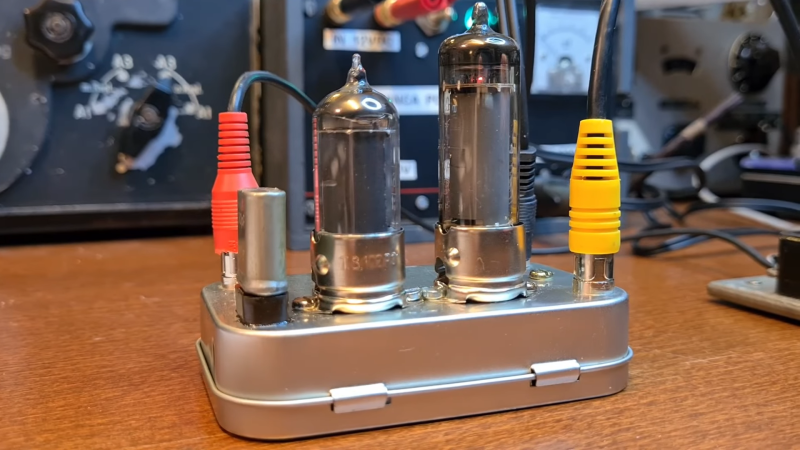It’s been a long time since vacuum tubes were cutting-edge technology, but that doesn’t mean they don’t show up around here once in a while. And when they do, we like to feature them, because there’s still something charming, nay, romantic about a circuit built around hot glass and metal. To wit, we present this compact two-tube “spy radio” transmitter.
From the look around his shack — which we love, by the way — [Helge Fykse (LA6NCA)] really has a thing for old technology. The typewriter, the rotary phones, the boat-anchor receiver — they all contribute to the retro feel of the space, as well as the circuit he’s working on. The transmitter’s design is about as simple as can be: one tube serves as a crystal-controlled oscillator, while the other tube acts as a power amplifier to boost the output. The tiny transmitter is built into a small metal box, which is stuffed with the resistors, capacitors, and homebrew inductors needed to complete the circuit. Almost every component used has a vintage look; we especially love those color-coded mica caps. Aside from PCB backplane, the only real nod to modernity in the build is the use of 3D printed forms for the coils.
But does it work? Of course it does! The video below shows [Helge] making a contact on the 80-meter band over a distance of 200 or so kilometers with just over a watt of power. The whole project is an excellent demonstration of just how simple radio communications can be, as well as how continuous wave (CW) modulation really optimizes QRP setups like this.
Thanks to [Stephen Walters] for the tip.















Cool. As a software guy, I envy guys that can can scratch out circuits on a piece of paper and make ’em work for their needs/wants. No ‘software’ here!
This is the advantage us old school timers have eh son! ;) Now let’s talk logic 101 with valves and punch cards and racks of 10 inch reels of 1 inch magnetic program tape! :p If And Nor Nand! :)
I just started seeing logic at the uni, any recomendations?
Nice little tube rig. I have some caps like that. I’ll bet they are metalized polyester caps. They’re available at tube friendly voltages, including neon lamp based logic circuits where I use these caps.
It needs to be stuffed into the heel of an oxford or wingtip ;)
Oxfords, not brogues :)
I’m thinking this will be EMP-safe, for use after a nuclear strike?
They will! In Russia, the inter-continental rail-road ballistic missiles systems are fitted with the valve Rx and Tx units. Simple nd easy. Let’s live in peace. Otherwise, you’ll inevitably… Take care!
MAD….isnt it!! Despite what our two respective gooberments Emmy award winning performance was on the public world stage back in the late 80s and early 90s…MAD has kept the planet intact since…and still does! Peace fellow human being! ✌☕👍
Very beautiful, now that I’m a little older, will restart making things like these. Perhaps a qso with Norwegian friend
Crystal controlled… sigh.
Holy retro radio novelty Hamman! :) Well aside from the multi voltages and currents needed for the tubes to function..especially those darn filaments..this is not anything unique as there are dozens of 50s and 60s and 70s era amateur radio handbooks and general electronics hobby publications which have similar and even one-tube designs….even using the same breath mints Altoids metal box! I have an entire bookshelf wall of these publications from those golden glowing years! 👍☕✌
Damn good! Likely to build one myself.. :-)